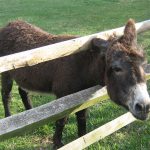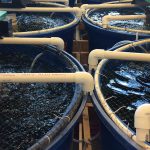
Introduction
Our progress as nations and as the human race is marked by the meat, milk, hides, draught power that cattle have provided. They also are an investment, and have served as an indicator of wealth and as articles for barter. It is not for nothing that the idiom Dikgomo ke banka ya Mosotho (cattle are the bank of a Mosotho) exists in Lesotho and South Africa.
Where cattle are kept for production, beef farming can be a primary or a secondary enterprise. In the latter instance, the farmer has more than one enterprise and the beef enterprise is the subordinate undertaking. Because beef farming can be a low input system in terms of costs, labour and time, it is a very useful enterprise to run as a secondary enterprise. Thus cattle often are retained to keep grass down on marginal areas or to utilize excess roughage such as crop residues, and may also be kept for aesthetic and/or cultural reasons where people merely like to have animals or believe that cattle must be present for ceremonial reasons.
For whatever reason livestock are kept, buying cattle is an investment, albeit a risky one because of disease and mortality. Characteristically, beef production is a long-term undertaking and profits are rarely made on the short term.
Source: www.sesotho.org and Beef Production, The Basics
Contents
Contents
International business environment
- There are currently just under 1-billion head of cattle in the world. India, Brazil, China, USA, EU, Argentina and Australia hold the most stock of cattle (USDA, 2023).
- The top producers of beef and veal are the USA, Brazil, China, EU, India and Argentina (USDA, 2023)
- The top exporters are Brazil, Australia, India, USA, and New Zealand. The top importers are China, USA, Japan, South Korea, EU and the UK (USDA, 2023).
Source: www.fas.usda.gov/commodities/beef-and-cattle
Further reference:
- Refer to updated information on global stocks and trade at https://apps.fas.usda.gov/psdonline/circulars/livestock_poultry.pdf.
- The annual Bureau for Food and Agricultural Policy (BFAP) Baseline puts South African beef farming in a global context. See www.bfap.co.za.
- Order the latest Beef Report at www.agribenchmark.org
- www.drovers.com “Drovers cattle network”
- BEEF magazine and its website, www.BEEFmagazine.com (USA)
- www.nbcec.org – the US National Beef Cattle Evaluation Consortium website
- For information on the red meat industry in Australia, visit www.trueaussiebeefandlamb.com or the website of Meat and Livestock Australia, www.mla.com.au.
- Find technical information and recipes at www.beefitswhatsfordinner.com.
- Specht, J. 2019, May 7. “The price of plenty: how beef changed America”. The Guardian. Available from www.theguardian.com/environment/2019/may/07/the-price-of-plenty-how-beef-changed-america
- The SADC Secretariat and German Development Corporation‘s Profiling of the Regional Agro-Processing Value Chains in the SADC Region (March 2019) included a look at beef.
South Africa imports and exports
- Beef exports reached 28 422 tonnes in 2022 (Sihlobo, 2023).
- The main markets for fresh beef were Kuwait (22%), Jordan (16%), Mozambique (13%), the United Arab Emirates (12%), and Qatar (9%). The main markets for frozen beef included Lesotho (16%), China (14%), Nigeria (14%), United Arab Emirates (9%), and Mozambique (7%) (Sihlobo, 2023).
- Beef exports accounted for 1% of agricultural exports in 2022, valued at USD151 million (Sihlobo, 2023)
Source: www.agbiz.co.za/document/open/challenges-facing-the-sa-livestock-industry-605
- Historic growth in beef exports has been one of agriculture’s success stories. Beef exports had grown at an average annual rate of 18% between 2011 and 2021,leading to the projection of a possible 24% of beef production going to the export market by 2030 (BFAP, 2021). The scenario of improved traceability systems has not materialised. On-going foot-and-mouth disease (FMD) outbreaks have caused previous gains to stall. The share of beef production going to export markets declined to 5% on average between 2020 and 2022, and is projected to only be 4% by 2032 (BFAP, 2023).
- Read the discussion under heading 6 on how the Agriculture and Agroprocessing Masterplan would enable greater participation from developing producers in supplying additional weaner calves.
Source: excerpts from Bureau for Food and Agricultural Policy (BFAP) Baselines 2023-2032, 2021-2030.
Local business environment
There are over 12.2 million cattle in South Africa (DALRRD, 2023). Beef is produced throughout South Africa. The amount of beef produced depends on the infrastructure such as feedlots and abattoirs, not necessarily by the number of cattle available in those areas. South Africa has highly developed transport infrastructure that allows movement of cattle and calves from one area to another, even from other countries such as Namibia. Mpumalanga, the Free State and Gauteng command the greatest share of beef production in South Africa.
Three major groups of beef cattle farmers co-exist in the country: (i) The commercial beef producer where production is relatively high and comparable to developed countries. Their production is generally based on synthetic breeds and/or crossbreeding, using Indicus / Sanga types and their crosses as dams. (ii) The emerging black beef cattle farmer, whose cattle generally consist of indigenous crossbred or exotic type of animals. (iii) The communal beef cattle farmer who farm on communal grazing land. Their cattle are mostly of indigenous types.
The beef supply chain has become increasingly vertically integrated. This integration is mainly fuelled by the feedlot industry where most of the large feedlots own their own abattoirs, or at least have some business interest in certain abattoirs. In addition, some feedlots have integrated further down the value chain and sell directly to consumers through their own retail outlets. Some abattoirs have also started to integrate vertically towards the wholesale level.
A good maize crop with accompanying lower maize prices is good news for the beef industry (feedlots make better money since they are not spending as much on animal food). Bad news has been drought conditions which lead farmers to sell off cattle, leading to an oversupply in the market causing the price paid for beef to drop.
Source: The Beef Market Value Chain Profile at www.dalrrd.gov.za, website of the Department of Agriculture, Land Reform and Rural Development (DALRRD); DALRRD’s Abstract of Agricultural Statistics 2022.
Useful sources for national information on cattle:
- Statistics and reports can be found at www.dalrrd.gov.za, www.redmeatsa.co.za and other websites linked to the Red Meat Industry Forum e.g. www.rpo.co.za and www.safeedlot.co.za.
- The annual BFAP Baseline at www.bfap.co.za provides overviews of all agricultural commodities, including beef.
- Find the weekly ABSA Agri Trends Livestock Report at www.absa.co.za/business/sector-solutions/agribusiness/agri-smart-insights/
For the newcomer
- Find the Codes of Good Practice on www.rpo.co.za. These set out steps for the successful cattleman (or cattlewoman).
- Find the many publications and articles listed under the “Websites & publications” heading.
Beef cattle: the weaning of calves
It is important to decide when and by what means to wean beef calves, because it influences the weaning mass of calves as well as the condition of the cows, and indirectly their conception rates.
Timing:
- The major priority in beef production is to produce as many calves as possible. The main objective of weaning is therefore to enable a cow to calve every year by allowing her to regain condition after weaning.
- Calves are ideally weaned when they are 7 to 8 months old.
- The right time to wean a calf depends on the condition of the cow and not the age of the calf.
- Calves should be weaned before the condition score of the cow falls below 2,5 if adequate winter feed is available and the cows maintain their condition. The calves should preferably be weaned before the cows condition score falls below 3,0.
- During years of drought and poor feed supply, calves should be weaned early (about 6 months), to allow the cow to recover before the onset of winter.
- It is important that the cow should recover and that the secretory tissue be restored before the next calf is born.
- In the eastern parts of the country calves born during spring can be weaned early in May at the age of about 7 to 8 months.
- In the more western parts calves can be weaned late in May or early June at the age of about 7 to 8 months as the breeding season tends to be later in these areas.
Early Weaning:
- This practice should only be considered during times of severe drought or feed shortages.
- Calves weaned at a relatively young age (less than 5 months) experience severe setbacks.
- If the condition of the cow deteriorates considerably before the planned weaning time, the producer must decide whether to – Wean early and supply concentrate feeding to the calf – Provide a roughage supplement to the cows that are still suckling their calves.
- This decision will depend on the availability and cost of feed. Generally, the feed (mainly concentrates) costs to rear early weaned calves are relatively high. Therefore, feeding concentrates to calves should only be considered during adverse conditions. Methods of Weaning: Circumstances on the farm determine the method of weaning.
The following methods can be used:
- Keep the calves in a kraal or well-fenced camp and remove the cows to a distant camp, preferably out of earshot of the calves.
- Remove the cows temporarily from a camp and in their absence move the calves to another distant camp. Cows tend to look for their calves in the camp in which they were last seen and this method should prevent the cows from breaking out of the camp.
- Exchange calves from two different herds. The calves will then have the company of cows. Some cross suckling is, however, likely to occur.
- Separate the cows and calves by a strong, close-strand wire fence. This method can reduce weaning stress.
- Nose plates, commercially available or homemade, can be fitted to calves for 7 to 14 days. These prevent suckling, even if cows and calves remain together throughout the weaning period. When the nose plates are removed the cows and calves are separated, but with relatively little stress.
General:
- Perform castration, dehorning and branding when calves are 2 to 3 months old, not immediately before weaning. This will ensure that the stress associated with these operations does not add to that of weaning.
- A few dry cows can be kept with the weaners to calm them.
- Provide sufficient good-quality roughage, water and shade in the weaning camps.
- To prevent excessive walking and trampling the camps should not be too large.
- The weaning process could last 7 to 14 days, depending on the age at which the calves are weaned as well as the breed of the cow.
Source: The Info Pak “Beef cattle – weaning of calves” on www.dalrrd.gov.za
The Case for NoseRings
NoseRing is an agricultural product used for stress-free weaning of livestock – without having to separate the young animal from its mother. This results in weight gains during weaning for both mother and young. This means healthier, more robust livestock, no damage to fencing and kraals, higher conception rates – and happier farmers!
Feedlotters benefit from purchasing weaners that were weaned using low-stress weaning methods. For more information visit www.nosering.co.za.
Caution: Under no circumstances are home-made devices to be used. Incorrect usage could render farmers liable for prosecution under the Animals Protection Act, 71 of 1962.
The importance of information for adequate livestock marketing
Livestock producers are regularly faced with the decision whether animals should be sold, slaughtered, or kept in the hope for better prices.
Agricultural product prices, and especially livestock and meat prices, are influenced by a large number of variables like feed prices, seasonality, rainfall and product demand; to name just a few. This creates a lot of uncertainty as to when producers should market their animals as well as for making production decisions for upcoming seasons. Hence, these decisions should be based on timely, accurate and transparent market information as they are critical for ensuring long-term profitability.
Unfortunately, this type of information, such as slaughtering numbers and meat prices, is often not readily available to South African livestock producers. This forces the producer to base his marketing and production decisions on inadequate information; which can have significant negative effects on his profitability. The importance of the availability of information is not limited to the producer level.
For the meat value chain to function effectively, there has to be timely and accurate information, including product flow and prices to all the segments of the value chain. It is important to know how costs and profits are distributed along the value chain to ensure the effectiveness of the system, given the very dynamic nature of the industry this is a major challenge.
There are a number of ways in which role players in this sector can minimize production risk. A good starting point is consulting industry experts that are knowledgeable and informed with regards to seasonal trends and current market conditions.
Source: Dr DC Spies, School for Environmental Sciences and Development at the North-West University. Contact him at 018 299 2373 or David.Spies (at) nwu.ac.za.
Perspectives on incorporating the informal market
An estimated 40% of the national herd is in the hands of communal farmers, who are underrepresented in the beef value chain. The low productivity and unrealised potential here is attributed to (i) there being too many male animals in the herd (55%) and (ii) the low calving percentage (below 35%) (BFAP, 2021). The BFAP Baseline 2021-2030 set out how matters could be improved: “If the female share in this herd can be increased to 60% and the calving percentage improve to 60%, the number of marketable weaners (70% of production) will increase by 129% or 793 800 animals (33% of SA’s total cattle slaughters for 2020) valued conservatively at nearly R4 billion”.
Some role players and initiatives
- If the Agriculture and Agroprocessing Masterplan can sort out the issues of identification and traceability for the national herd, export growth can be accelerated substantially, which would enable greater participation from developing producers in supplying additional weaner calves (BFAP, 2022, 2021, 2020).
- The National Red Meat Development Programme (NRMDP) took over from where the Eastern Cape Red Meat Project began in 2005. In 2019/20 it benefitted over 1 000 farmers, generating an income of close to R24 million, and about 3 000 cattle sold in formal and informal markets (NAMC, 2020). It had been a success story until September 2020, after which the ball has been dropped by the NAMC, ARC and DALRRD. Read the Parliamentary Monitoring Group’s minutes on the crisis meeting (2021, May 26) at https://pmg.org.za/committee-meeting/33079/.
- The Meat Naturally initiative in the northern Eastern Cape has achieved great success in improving incomes while restoring rangelands. It is a project under the Umzimvubu Catchment Partnership which consists of several role players: Conservation SA, LIMA, Institute of Natural Resources (INR) and Environmental & Rural Solutions (ERS).
- Read about the ARC’s Kaonafatso ya Dikgomo (KyD) programme on the “Animal improvement and breeders” page.
- NERPO (see later “Associations involved” heading) has the mandate “to commercialise the developing agricultural sector and ensure meaningful participation of black individuals within the mainstream commercial agribusiness sector”. Find more at www.nerpo.org.za.
- Read about the AgriBEE Beef Fund for “assisting Black small holder farmers to actively participate in the value chain of commercial A-grade beef production”at www.berlinbeef.co.za/content/agribee-beef.
The Agricultural Policy Action Plan (APAP) 2015-2019 tackled beef under “The red meat value chain”. The analysis and its goalposts remain valid.
- To double the production of livestock here and arrive at the commercial potential, APAP saw the following as important: (1) improving the market linkages (2) improving the veld and herd management practised in the communal sector.
- Support would include preparing communal farmers to meet market requirements, partnerships with the private sector on infrastructure like abattoirs and keeping an eye on competition policy to ensure that no smallholder was unfairly disadvantaged against big, mechanised production units.
- It saw “inadequate border controls” between South Africa and neighbouring countries as contributing to stock theft, overgrazing and biosecurity risks. The APAP regarded as “critical” the maintaining of the country’s Foot and Mouth Disease (FMD) free status. Based on the BFAP outlook for this sector, the APAP saw potential for another 41 100 jobs here. Some trade measures were also identified, like addressing current barriers to exports market among most African states.
Some articles:
- Read the Agribook blog “Turning livestock owners into livestock farmers“, a success story about Meat Naturally, a project in the Eastern Cape about bringing livestock owners into the value chain, and “New study identifies best practice in livestock production and marketing for small emerging farmers” (2021, August 31) in which the Meat Naturally is championed.
- Refer to “Box 5: Opportunities for inclusive growth in South Africa’s beef sector” in the BFAP 2021-2030 Baseline.
- Lubinga, M., Mazibuko, N. & Sotsha, K. 2018, November. “Comparing prices received by participating and non-participating farmers in the custom feeding initiative of the National Red Meat Development Programme: A case of KwaZulu-Natal Province”. The Trumpet. Available at www.namc.co.za/wp-content/uploads/2018/12/The-Trumpet-Issue-4-30-November-2018.pdf
- Sotsha, K., Fakudze, T, Mnbengwa, V. et al. 2018. “Factors Influencing Communal Livestock Farmers’ Participation into the National Red Meat Development Programme (NRMDP) in South Africa: The Case of the Eastern Cape Province”. The Trumpet, Issue 3. Available at www.namc.co.za/wp-content/uploads/2018/07/The-Trumpet-Issue-3-24-July-2018.pdf
National strategy and government contacts
Find the note on the Agriculture and Agroprocessing Masterplan under the previous heading.
Contact details for and information on all directorates of the Department of Agriculture, Land Reform and Rural Development (DALRRD) can be found at www.dalrrd.gov.za. Relevant to this page is the Directorate Animal Production.
Associations involved
Refer to the role players heading further down this page for contact details and websites of the associations.
The primary role players in the red meat industry, namely the Red Meat Producers’ Organisation (RPO), the National Emerging Red Meat Producers’ Organisation (NERPO), the South African Feedlot Association and the Red Meat Abattoir Association requested the Bureau for Food and Agricultural Policy (BFAP) to set a vision 2030 for the red meat industry.
The resultant strategy “is extremely inclusive and has the potential to add R12 billion to the nett worth of the red meat industry. It is also in line with the master plan which has been finalised in collaboration with all the role players as well as the Department of Agriculture, Land Reform and Rural Development” (RPO Circular, 2022).
The Red Meat Industry Services (RMIS) was created to deliver services like
- Animal health
- Research and development with special attention to innovation
- Traceability
- Inclusive growth
- Meat safety
- Trade (imports and exports)
- Production development
- Consumer matters
- Issues in the red meat industry
The main producer associations are the RPO, NERPO and SAFA (see below).
- RPO – Red Meat Producers’ Organisation The RPO is recognised as the mouthpiece organisation for commercial red meat producers and represents the highest authority within the red meat industry in terms of commercial producers’ interests in South Africa. Provincial contact details are available on the website.
- NERPO – National Emergent Red Meat Producers Organisation The primary aim of NERPO is to commercialise the developing agricultural sector and ensure meaningful participation of black individuals within the mainstream commercial agribusiness sector, hence ensuring the long term sustainability of the agricultural sector in South Africa.
- SAFA – South African Feedlot Association The SA Feedlot Association is an umbrella organisation that addresses collective interests of the South African Feedlot industry which collectively markets some 75% of the total beef produced in South Africa. Read about Q-Sure accreditation on the website.
Other associations:
The Grass Fed Association of South Africa (GFASA) was established “to enable primary producers to produce certified GrassFed and/or Free Range meat for consumers” (as opposed to being finished off on a maize diet).
The Regenerative Agriculture Association of South Africa are also proponents of grass fed beef cattle farming
- The Meat Industry Trust (MIT) and the Red Meat Research Development Trust (RMRDT)
- South African Meat Industry Company (SAMIC)
- Meat Statutory Measure Services (MSMS)
- Agricultural Levy Services (ALS)
- Livestock Welfare Co-ordinating Committee (LWCC)
Other member organisations are SHALC (see leather); SAFLA (see livestock auctions); RMAA (see abattoirs); SAPPO (see pork); RMRDSA (see next heading) and the Gauteng Meat traders Employees Union (GMETU). All Beef Breeder Societies are listed on the “Animal Improvement & breeders” page.
Visit the “Abattoirs” page for contact details of associations like the Association of Meat Importers and Exporters of SA (AMIE), Red Meat Abattoir Association (RMAA), South African Meat Processors Association (SAMPA) and the South African National Consumers Union (SANCU).
Training and research
Refer to the role players heading further down this page for contact details and websites of the training providers and research bodies.
The universities offer degree courses on animal production. Diplomas are offered by universities of technology and Agricultural Colleges. The Provincial Departments of Agriculture work closely with the Agricultural Colleges to offer short courses on animal production. Details of all training providers can be found on the “Agricultural education and training” page.
Companies involved
Find these below. See also this heading on the “Abattoir” page. Software providers are listed on the “Animal improvement & breeders” page.
Role players
Contact details for a number of feedlots can be found in DALRRD’s Beef Market Value Chain Profile (see next heading).
Websites and publications
Visit the websites listed earlier on this page.
See if the Directorate Marketing has resumed publishing the annual Beef Market Value Chain Profile under the “Annual publications” on the Directorate Marketing web pages at www.old.dalrrd.gov.za, website of the Department of Agriculture, Land Reform and Rural Development (DALRRD).
Find Red Meat Marketing, one of the series of Agricultural Extension Training Papers on the same website. Relevant Info Paks on the website include (i) Beef Cattle: dehorning (ii) How to estimate the age of cattle (iii) Beef Cattle: Castration (iv) Beef Cattle: weaning of calves (v) Cattle: Condition scoring of cattle (vi) Methods of tick control in cattle. Also look out for the following: (i) The excellent Agricultural Marketing Extension Papers Paper no. 7 covers Red Meat Marketing (ii) Establishing and managing a small herd of beef cattle (iii) Guidelines for planning and construction of a feedlot (iv) Beef cattle management.
Find the many guidelines on beef production on the KwaZulu-Natal Department of Agriculture website at www.kzndard.gov.za.
- The Basics
- Beef Cattle on Veld
- Beef Production Systems
- Breeding and Selection in the Beef Herd
- Breeding Seasons
- Bull Management
- Calf Housing
- Calf Rearing, Castration and Dehorning
- Cattle Handling Facilities
- Cattle Identification
- Crop Residues for Animal Feeding
- Drought
- Feedlotting Cattle
- Fencing
- Heifer and Cow Management
- Herd Structures for Different Systems
- Hides
- Management Principles
- Marketing
- Nutrition
- The Beef Carcass Classification System
- Transporting Cattle
- Trough Requirements for Cattle
- Useful Statistics (e.g. expected calving date)
- Water Requirements of Livestock
Contact 012 672 9111 – the ARC at Irene – for the following publications: (i) Beef Cattle (complete set of Bulletins, available in Afrikaans or English) (ii) Feedlot Management CD (iii) Beef Management CD (iv) Beef Breeding in South Africa. The ARC at Silverton can be reached at 012 842 4017. The following publications are relevant to this chapter: (i) Handleiding oor vleisbeesfasiliteite (ii) Beef cattle facilities manual (iii) Manure handling in intensive animal production units, written by HT Breedt, edited and revised by F Cilliers. Copyright. 2009.
Kejafa Knowledge Works stock a number of livestock publications. Visit www.kejafa.com for information about books which include the following: (i) Essential Guide to Calving by Heather Smith Thomas (ii) The ABC of Beef Production by Schalk J Viljoen (iii) No risk ranching G Judy (iv) Essential Guide to Calving: Giving Your Beef or Dairy Herd a Healthy Start Heather Smith Thomas (v) Herd Bull Fertility James E Drayson (vi) Getting Started with Beef & Dairy Cattle Heather Smith Thomas (vii) Grass-fed cattle by Julius Ruechel (viii) Natural Cattle Care Pat Coleby (ix) Reproduction and Animal Health C Walters and G Fry (x) Knowledge Rich Ranching Allan Nation (xi) Raising Beef Cattle Heather Smith Thomas (xii) Vleisbees Produksie (xiii) Ranching full time – 3 hours a day (xiv) Grassfed to Finish.
Find the “Red meat” option at www.agriconnect.co.za.
The Savory Institute, www.savory.global, found that grazing animals play a crucial role in combating one of the major causes of climate change – desertification.
Visit www.grassfednetwork.com for information on finishing cattle off on grass rather than on grain.
Find the NSPCA educational resources which include Transport your cattle correctly (available in Afrikaans, English, Sotho, Tswana, Xhosa, Zulu) at https://nspca.co.za/educational-resources.
Nation in Conversation took a look at intensive meat production (2018, September 12). Find “Intensiewe veeboerdery se rol in volhoubaar vleisproduksie” and the earlier overview of the beef industry (March 2017) on YouTube.
There are many other videos on YouTube like “Cattle”, “How to start a cattle farm”, “Making money with cattle” etc.
V.Reddy, V., Goga, S., Timol, F. & Molefi, S. 2016. The socioeconomics of livestock keeping in two South African communities: a black man’s bank. Available at www.hsrc.ac.za/en/research-data/view/8099
Find the Johannesburg Stock Exchange (JSE) Beef Carcass Futures Contract at www.jse.co.za/livestock
Lymberry, P and Oakeshott, I. 2014. Farmageddon: The True Cost of Cheap Meat. London: Bloomsbury.
Buy shares in beef cattle. Visit www.livestockwealth.co.za. See also Beeswinkel https://beeswinkel.co.za, an online auctions platform.
Some articles
Sihlobo W. 2023, April 18. “Challenges facing the SA livestock industry”. Agbiz. Available at www.agbiz.co.za/document/open/challenges-facing-the-sa-livestock-industry-605
Reporter. 2022, November 22. “SA beef industry taps into Saudi’s Halal market”. Bizcommunity. Available at www.bizcommunity.com/Article/196/472/233359.html
Sihlobo W. 2022, July 3. “South Africa’s livestock industry is constrained by biosecurity challenges”. Available at www.agbiz.co.za/document/open/sas-livestock-industry-is-constrained-by-biosecurity-challenges
Hofmeyr I. 2022, June 16. “The gift of grass-fed meat”. AgriOrbit. Available at https://agriorbit.com/the-gift-of-grass-fed-meat
Read our blog “New study identifies best practice in livestock production and marketing for small emerging farmers” (2021, August 31).
Reporter. 2021, July 29. “Traceability and biosecurity essential for SA’s beef industry”. Available at https://beefmaster.co.za/2021/07/29/traceability-and-biosecurity-essential-for-sas-beef-industry/
Majola G. 2021, April 21. “Beef sector eyes growth of its export footprint”. Business Report. Available at www.iol.co.za/business-report/economy/beef-sector-eyes-growth-of-its-export-footprint-dfef5f5b-4f4c-4285-b7e4-2f847d2d726f
Sihlobo W. 2020, January 30. “Livestock traceability key to driving SA beef exports”. Available at https://wandilesihlobo.com/2020/01/30/livestock-traceability-key-to-sa-beef-driving-exports/
Find Farmer’s Weekly articles (mainly) on its website, www.farmersweekly.co.za/animals/cattle/ Examples:
- Coleman A. 2023, March 14. “What feedlots expect in the ideal weaner”. Farmer’s Weekly. Available at www.farmersweekly.co.za/animals/cattle/what-feedlots-expect-in-the-ideal-weaner/
- Staff reporter. 2022, December 8. “Read this before buying a bull for your beef herd!” Farmer’s Weekly. Available at www.farmersweekly.co.za/animals/cattle/read-this-before-buying-a-bull-for-your-beef-herd/
- Kriel G. 2021, March 21. “Beef cattle basics: Choose the right breed for your farm”. Farmer’s Weekly. Available at www.pressreader.com/south-africa/farmers-weekly-south-africa/20210312/281539408703534
- Staff Reporter. 2019, October 11. “Growing out and fattening cattle in a feedlot”. Farmer’s Weekly. Available at www.farmersweekly.co.za/farm-basics/growing-fattening-cattle-feedlot/
- Dean, S. 2019, June 26. “Laying the foundations for commercial farming”. Farmer’s Weekly. Available at www.farmersweekly.co.za/animals/cattle/laying-the-foundations-for-commercial-farming
- Coleman, A. 2019, April 9. “Grass-fed beef: the trend that favours communal farmers”. Farmer’s Weekly. Available at www.farmersweekly.co.za/animals/cattle/grass-fed-beef-the-trend-that-favours-communal-farmers/
- Brody, S. 2018, November 13. “Cattle branding: how to get it right every time”. Farmer’s Weekly. Available at www.farmersweekly.co.za/farm-basics/how-to-livestock/cattle-branding-get-right-every-time/
- Reporter. 2018, April 23. “Feeding cattle: learn the basics”. Farmer’s Weekly. Available at: www.farmersweekly.co.za/farm-basics/how-to-livestock/feeding-cattle-learn-basics/
- Coleman, A. 2017, December 6. “Better heifers, bigger profits”. Farmer’s Weekly. Available at www.farmersweekly.co.za/farm-basics/how-to-livestock/better-heifers-bigger-profits/
Find the Meadow Feeds technical articles for beef cattle at www.meadowfeeds.co.za/technical-articles/beef/
Reporter. nd. “Livestock farming – calculate production cost per unit”. Show Me Rustenburg. Available at https://showme.co.za/rustenburg/industry/agriculture/livestock-farming-calculate-production-cost-per-unit/
De Bruin, L. 2015. “The ethics of meat production”. University of Pretoria. Available at www.up.ac.za/en/production-animal-studies/news/post_2130821-the-ethics-of-meat-production



Share this article






